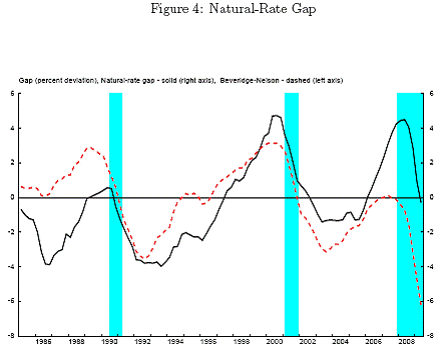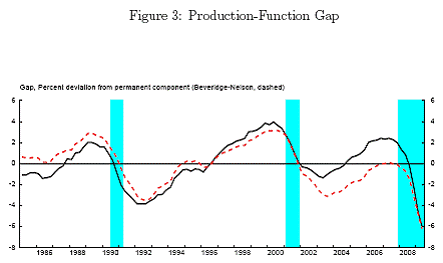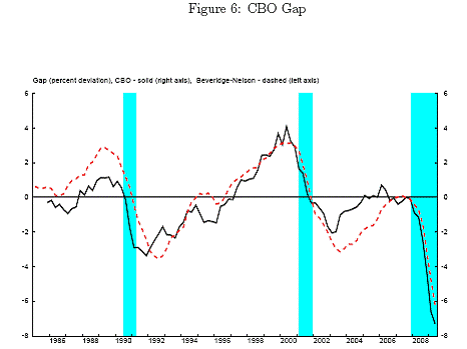Econbrowserのメンジー・チンが「Mind the Gap*1」と題した6/1エントリ*2でGDPギャップについて書いている。内容は基本的にFRBのMichael T. Kileyが書いた論文「Output Gaps」の紹介となっている。
該当論文の要旨は以下の通り。
What is the output gap? There are many definitions in the economics literature, all of which have a long history. I discuss three alternatives: the deviation of output from its long-run stochastic trend (i.e., the "Beveridge-Nelson cycle"); the deviation of output from the level consistent with current technologies and normal utilization of capital and labor input (i.e., the "production-function approach"); and the deviation of output from "flexible-price" output (i.e., its "natural rate"). Estimates of each concept are presented from a dynamic-stochastic-general-equilibrium (DSGE) model of the U.S. economy used at the Federal Reserve Board. Four points are emphasized: The DSGE model's estimate of the Beveridge-Nelson gap is very similar to gaps from policy institutions, but the DSGE model's estimate of potential growth has a higher variance and substantially different covariance with GDP growth; the natural rate concept depends strongly on model assumptions and is not designed to guide nominal interest rate movements in "Taylor" rules in the same way as the other measures; the natural rate and production function trends converge to the Beveridge-Nelson trend; and the DSGE model's estimate of the Beveridge-Nelson gap is as closely related to unemployment fluctuations as those from policy institutions and has more predictive ability for inflation.
(拙訳)
GDPギャップとは何であろうか? 経済学の分野では数多くの定義があり、それぞれに長い背景の歴史がある。ここでは3種類の定義について取り上げる。
- 生産水準の長期的な確率変動トレンドからの乖離(即ち、「ベバレッジ=ネルソン循環*3」)
- 現在の技術ならびに通常の資本の稼動水準および労働の投入と整合的な生産水準からの乖離(即ち、「生産関数アプローチ」)
- 「伸縮的な価格」における生産水準との乖離(即ち、「自然率」*4)
それぞれの概念のGDPギャップを、FRBで使用されているDSGE米国モデル*5を用いて推計した。その推計結果に関し、4つのポイントを強調しておきたい。
- DSGEモデルによるベバレッジ=ネルソン・GDPギャップの推計結果は、政策機関の推計したGDPギャップと非常に似通っているが、DSGEモデルにより推計した潜在成長率は分散がより大きく、GDP成長率との共分散もかなり違っている。
- 自然率の概念はモデルの前提に強く依存し、他のGDPギャップの尺度のように「テイラー」ルールに当てはめて名目金利の指標とするのにはそぐわない。
- 自然率と生産関数の推計値のトレンドは、ベバレッジ=ネルソンの推計値のトレンドに収束する。
- DSGEモデルによるベバレッジ=ネルソン・GDPギャップの推計結果は、政策機関の推計したGDPギャップと同じくらい失業率の変動と相関している半面、インフレについては予測力がより高い。
以下が実際の推計結果のグラフ(各図の赤点線がベバレッジ=ネルソン・GDPギャップ)。
●自然率GDPギャップ

エントリの最後でチンは、以下のようにコメントしている。
For me, one important observation is that the output gap for both the production function based approach from EDO and the CBO estimate are of similar magnitude; 6 ppts and 7.5 ppts of GDP at 09Q2. The natural rate output gap is quite different, and this highlights the fact that this gap embodies a very different concept (discussed at length in the paper). I stress this, exactly because I know somebody is going to take some output gap measure and mis-interpret the implications of that gap -- especially as concerns of inflation rise.
(拙訳)
私からすると、一つの重要な結果は、EDOによる生産関数アプローチのGDPギャップがCBOの推計値と似たような大きさになった点だ。即ち、2009年の第2四半期について、それぞれGDPの6%と7.5%になっている。自然率のGDPギャップは大きく違っているが、そのことは、このGDPギャップが非常に異なった考え方に基づいているという事実を明らかにしている(論文ではその点について紙数を割いて論じられている)。私がこのことを強調しておきたいのは、GDPギャップの適当な尺度を拾い上げて誤った解釈をする輩が必ず現われるからだ――特にインフレ懸念が高まった時には。
ちなみに上記のコメントは、冒頭の以下の前振りを受けたものである。
Even as inflation continues to fall, there are calls to raise interest rates soon in order to quell inflationary pressures. I remember reading similar calls for monetary restraint in Japan in 2000-01, when that country was struggling to escape deflation (I sure had a hard time explaining the fears to my boss, and indeed never came up with a good answer).
(拙訳)
インフレ率が低下し続けているにも関わらず、インフレ圧力を沈静化させるためにすぐに金利を引き上げるべき、という声が存在する。日本で2000-01年に似たような金融引き締めを求める声が上がっていたのを目にしたことを思い出す――当時日本はデフレを逃れようともがいていた時期だったのだが。(そうした懸念を上司に説明するのに非常に苦労したが、結局満足な回答を出せなかった*7)
*2:[2017/7/22]リンク先修正(先頭のwwwと末尾の.htmlを削除)。
*3:これについての日本語での説明は、たとえばこの論文のpp.14-15やこの論文のpp.12-13を参照。
*4:池尾和人氏も注目したunrepresentative agent氏のブログエントリでは、別の論文(Kiley論文のリファレンスにも挙げられているJustiniano, A., and G. E. Primiceri (2008) “Potential and Natural Output” mimeo, Northwestern University.)を基にこの概念を説明している。
*5:EDO (Estimated, Dynamic, Optimization-based) model。このモデルの名前のエピソードに関しては矢野さんのツイート参照。
*6:[2017/7/22]リンク先修正(先頭のwww.econbrowser.com/archives→econbrowser.com/wp-content/uploads)。以下同様。

